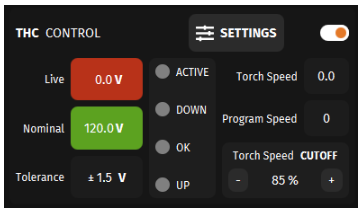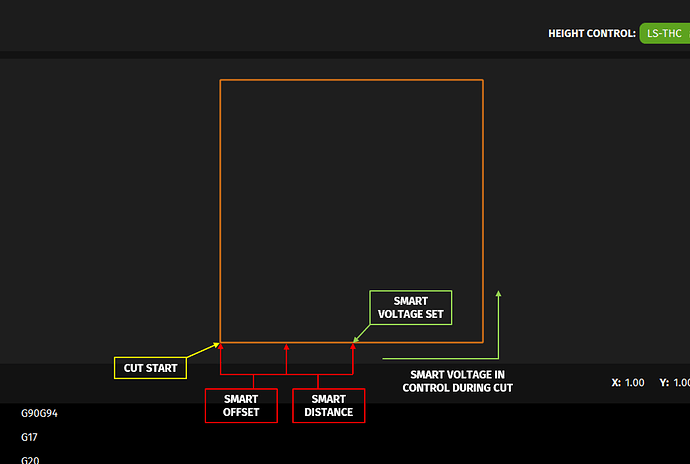Is everyone just using smart voltage? I’m understanding THC a little better now, and I now understand that Hypertherm gives a suggested voltage for THC on the cut charts. Whats everyone else doing?
I used both depending But mostly nominal.
A couple things to keep in mind with smart voltage
If spring back or a nub of slag or something affect your initial cut height the smart voltage number sensed could be too high or low and will maintain the incorrect height throughout the cut.
when doing small geometry the smart voltage takes lets say .375" of travel length to sense and start using smart voltage where with nominal voltage this happens immediately.
so, is the difference between that THC voltage and what you set the cut height to in CAM, that the voltage is used to maintain the height? Whats the difference between lowering the set cut height in CAM and using a lower voltage in THC? I ask this, because in the user manual from Hypertherm, it talks about adjusting the THC voltage to lower the torch if its too high. well, wouldnt you just enter a lower number in CAM?
They’re probably talking and respect to nominal voltage cuz nominal voltage will maintain the book cut height even if you set your cam for three times that height because it only cares about the voltage across the arc. If you could copy and paste that citation it’s likely talking about after a while of cutting you’ll have to adjust the voltage for consumable wear.
With smart voltage no matter what cut height you put in whatever it senses in the first millisecond of operation is what it’s going to run that cut height regardless of whether it’s correct or not.
Where with nominal voltage it will drop to the correct cut height even if you’ve entered to large of a cut height.
It’s the one reason that when you look in fire control they have an asterisk on smart voltage saying it’s only for 14 gauge and higher because the spring back in the material could screw up your cut height setting and then smart voltage will continue with that incorrect setting for the remainder of the cut.
this is great info. thats for that. I have noticed when i cut 14-16 gauge that the height seemed too high. and, I cut a circle for a guy out of 26 gauge and it was WAAY to high.
Now if you have settings you use all the time that aren’t on the charts with nominal voltage.
Do a few straight line cuts with smart voltage and the average of that you could start using for nominal voltage.
I cut quite a bit of 26 gauge galvanized which I run at 300 in per minute which ends up not having the same nominal voltage as the book settings at 325 in per minute so I have a slightly modified nominal voltage I use for cutting that material.
Im curious. How do you turn off smart voltage and go to nominal? I tried to give nominal voltage a chance today but couldnt find a box to tick of or something like that in the THC menu. Coud you post a screenshot? This would be very helpful.
Thank you!
I had the same confusion when I tried. When you open up the settings in THC you will see the voltage spot. If you have “0” volts it automatically triggered for “Smart Voltage”. Any other numbers will be viewed as and trigger “nominal voltage” to be assigned as the target voltage.
I haven’t done it in a while, but I think you just click on the green box that says “smart” and type in your nominal voltage.
You can read all about it here:
https://www.langmuirsystems.com/thc/guide
Here is the area specifically talking about nominal voltage:
Nominal Voltage
The Nominal Voltage can be set manually in the THC settings menu. The Nominal Voltage is the target plasma arc voltage value that the THC system will work to maintain during cutting. Remember that the THC system works by automatically adjusting the torch height (z-axis) in order to keep a fixed arc voltage (the Nominal Voltage) throughout the cut. The Nominal Voltage can be set anywhere between 1 - 300V.
NOTE: THE MAXIMUM INPUT VOLTAGE FOR THE VIM MODULE IS 300V. DO NOT EXCEED THIS INPUT VOLTAGE! IF YOU ARE UNSURE ABOUT THE VOLTAGE OUTPUT OF YOUR PLASMA CUTTER DURING CUTTING, CONTACT YOUR PLASMA CUTTER MANUFACTURER FOR COMPLETE SPECIFICATIONS.
Choosing a Nominal Voltage for each cut will depend on many factors such as your plasma cutter, material thickness, cutting amps, material type, and the cutting feed rate. While many plasma cutter manufactures will include a table for cutting voltages based on material type and thickness, these values are more of an idealized condition and should not always be used absolutely. The best way to determine your Nominal Voltage is to perform a line test and monitor the Live cutting voltage in FireControl. We recommend cutting an 8-10” line at the desired cut speed and amperage for a given material and then entering this voltage value as the Nominal Voltage before cutting your part. To do this, jog your torch down to the material until you are at the ideal cut height. Next, turn off your electronics box and unplug the Z-axis motor from the electronics enclosure and run the line test while monitoring the Live voltage (note: your line test cannot include an IHS loop or FireControl will throw an alarm). The below image shows how FireControl should look when a Nominal Voltage of 120V is entered.

I struggle with trying to understand why the two options of Smart vs Nominal? If the ultimate goal is to maintain the desired torch height, why not just one method? Is the Smart voltage similar to the “automatic” of cut height, and the Nominal voltage simialr to the “5-speed” of cut height, where you have more control in one mode than the other?
What is the effect of using Smart voltage on something like 20ga material where there is springback, but that value is ignored? Could/would it potentially make a huge pierce then try to acheive the preset Smart voltage value?
I think I have a good grasp on both methods…I would just like to stay in one lane if it is possible with varying material thickness.
As always, I appreciate the help in understanding.
Too low of cut height would be the likely effect. once smart voltage takes affect it tries to maintain the cut height from that point on regardless of the program height. So if you IHS off a pellet of slag then your cut height will be high and smart voltage will just run with that, alternatively if the sheet flexes and spring back after the IHS then the cut could be low. Other disadvantage of smart voltage is that need an extra +/- 1/4" of travel before it activates when compared to using nominal.
If you open the setting menu for the THC in FireControl it does have a warning against using smart voltage for thickness less then 14ga.
Hey Tim, if I am understanding LS info correctly, it’s 1/4" for Smart Offset (stabilizing voltage after pierce), then another 1/4" for the Smart Distance (measuring/est nominal). Those 1/4" are defaults and can be reduced.
Is that right? If so, I think I may have to get off my a$$ and start using Nominal. I’ve been cutting everything with Smart active. I cut mostly 18-22 gauge metal, so seems I am one who would benefit from using Nominal. Likely my cut quality would improve.
I guess because my signs rarely have any really fine detail I’ve gotten away with using Smart w/o much issue.
I don’t think you understand how Smart Voltage is calculated.
It is not a preset value. It is a measured value that gets measured for each cut loop. The IHS system uses your pierce and cut height values to start the cut. It cuts for .25" and takes the voltage readings during that first .25" and uses that as the Smart Voltage target for that cut loop.
The potential problem with Smart Voltage is that, if the IHS cycle resultls in an incorrect height, the Smart Voltage will keep the torch at that incorrect height.
Nominal voltage is input by the operator in Firecontrol for each cut program. That will cause Firecontrol to ignore your programmed cut height(after the cut starts) and use the nominal voltage value to keep the torch at whatever height that voltage results in.
I apologize, i do understand…i should have said “Nominal voltage” in the following paragraph, I apologize just a word mix up.
What is the effect of using Smart voltage on something like 20ga material where there is springback, but that value is ignored? Could/would it potentially make a huge pierce then try to acheive the preset Smart voltage value?
I think I have a good grasp on both methods…I would just like to stay in one lane if it is possible with varying material thickness.

